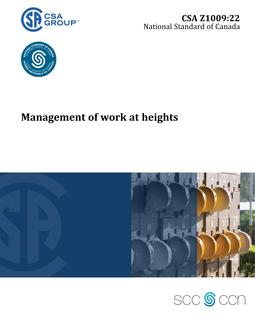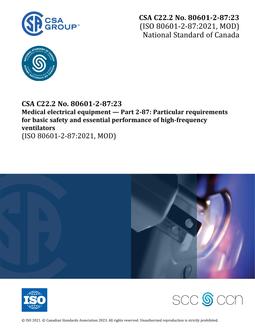
CSA Z1009:22
Preface
This is the first edition of CSA Z1009, Management of work at heights. It is based on the Plan-Do-Check-Act model set out in CSA Z45001, and it is designed to link CSA Group’s existing work-at-heights and fall-protection Standards with Canadian Standards on occupational health and safety management. The purpose of this Standard is to address the application of occupational health and safety management systems (OHSMS) to activities where a fall hazard exists. CSA Z1009 is the latest addition to the CSA Z1000 series of OHSMS Standards. It is designed to be used within an OHSMS in conjunction with the other Standards in the CSA Z1000 series. This Standard was developed by CSA Group with funding support provided by the Canadian Association of Administrators of Labour Law – Occupational Safety and Health (CAALL-OSH), including provincial and territorial governments, as well as the Government of Canada. CSA Group is solely responsible for the content of this Standard, and CSA Group and the funding bodies disclaim any liability in connection with the use of the information contained herein. This Standard was prepared by the Technical Committee on Management of Work at Heights, under the jurisdiction of the Strategic Steering Committee on Occupational Health and Safety, and has been formally approved by the Technical Committee. This Standard has been developed in compliance with Standards Council of Canada requirements for National Standards of Canada. It has been published as a National Standard of Canada by CSA Group.
Scope
1.1 General
This Standard, following the principles set out in CSA Z45001, specifies requirements for
a) establishing and maintaining a WAH management system in accordance with OHSMS principles;
b) the roles and responsibilities of the organization, the supervisor, and the workers;
c) management of contractors;
d) establishing the parameters of types of work at heights;
e) hazard identification and risk assessment related to work at heights; and
f) management and control of hazards and risk relating to work at heights, including
i) development of general safety procedures for work performed at heights;
ii) personal protective equipment (PPE) used for work at heights;
iii) health and safety monitoring systems for work at heights;
iv) emergency rescue plan development and implementation; and
v) training for work at heights.
This Standard recognizes that a fall from any height can cause physical injury to a worker. While local regulations may stipulate minimum heights at which fall-protection systems are to be used (including the regulation of maximum free-fall distances and the prevention of falling into or onto hazardous substances, objects, or surfaces regardless of working height), notwithstanding the exclusions in Clause 1.2, this Standard applies to the management of all work at heights in the workplace. Note: This Standard does not indicate a specific height at which a WAH management system should be initiated. Users are encouraged to follow the program development requirements (Clause 6) and complete the procedures for hazard identification, risk assessment, and risk mitigation. If after this procedure is complete, it is determined that actions are needed to reduce the likelihood of injury when the activities are below the minimum height specified in the local jurisdiction’s legislation, follow the hierarchy of controls (Clause 4.5.1.1) or adopt WAH management system clauses in this Standard, as appropriate, based on the level of risk. Document the rationale and decisions.
1.2 Exclusions
This Standard does not specifically address safety management of a) performing arts including, but not limited to, stunt work and aerial performances; and Note: The rigging of stage shows is covered under this Standard. b) individual recreational activities not performed in an employment context, such as mountain climbing and rock wall climbing.
1.3 Application
This Standard is designed to be used with related procedural Standards, as well as health and safety management Standards. It is intended to be referenced by other Standards as the primary set of requirements for health and safety management of work at heights. Although this Standard takes into consideration provincial, territorial, and federal legislation, it is not constrained by these regulations. It is intended to be used in conjunction with all provincial, territorial, or federal jurisdictions, and is designed for use in workplaces in all regions of Canada. This Standard is designed for voluntary application in Canadian workplaces. However, the principles established in this Standard are based on best practices recognized internationally. As such, they may be applied to any workplace performing work at heights.
1.4 Terminology
In this Standard, “shall” is used to express a requirement, i.e., a provision that the user is obliged to satisfy in order to comply with the Standard; “should” is used to express a recommendation or that which is advised but not required; and “may” is used to express an option or that which is permissible within the limits of the Standard. Notes accompanying clauses do not include requirements or alternative requirements; the purpose of a note accompanying a clause is to separate from the text explanatory or informative material. Notes to tables and figures are considered part of the table or figure and may be written as requirements. Annexes are designated normative (mandatory) or informative (non-mandatory) to define their application.
Product Details
- Published:
- 06/02/2022
- ISBN(s):
- 9781488344039
- Number of Pages:
- 86
- File Size:
- 1 file , 1.5 MB
- Product Code(s):
- 2430171, 2430171
- Note:
- This product is unavailable in Russia, Ukraine, Belarus


